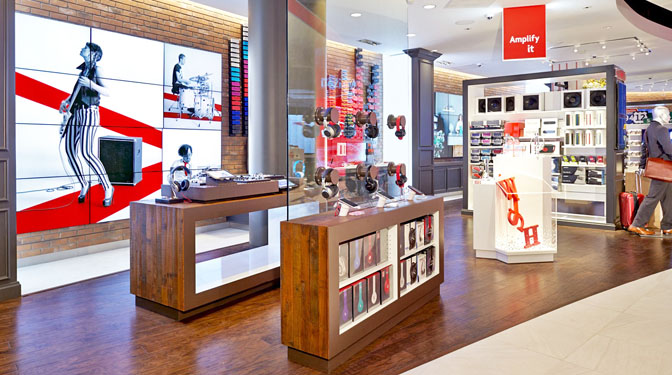
Commercial digital display solutions are expensive and not every business has the capex freedom to afford the upfront costs. These price tags loom even larger when customers realize a newly purchased hardware is a depreciating asset whose lifecycle they must extend beyond the technology’s peak usefulness to protect their return on investment (ROI).
商业数字显示解决方案是昂贵的,并不是每个企业都有资本支出前期成本。当客户意识到新购买的硬件是一种贬值的资产时,这些价格显得更高了。为了稳定投资回报率(ROI),他们必须将硬件的生命周期延长到技术的最高可用性之外。
Besides, most consumers are foreign to the complexity of these technologies. This unfamiliarity is a strong deterrent, especially if the business does not have the financial or human capital to invest in product trainings. Further still, display technology evolves quickly and customers are wary of buying something that may soon become obsolete, particularly when it may take a while to generate a positive return on initial costs. Together, these hurdles paint an intimidating picture for buyers who may ultimately forgo incorporating any large-scale visualization solutions despite the needs of their business and the evolving expectations of digitally reliant audiences.
此外,大多数消费者对这些技术的复杂性并不熟悉。这种未知感是一种强大的弊端,尤其是企业没有资金或人力资本投资于产品培训。此外,显示技术发展迅速,客户对购买可能很快过时的产品持谨慎态度,尤其是在可能需要一段时间才能实现初始成本的正回报的情况下。总之,这些障碍为买家描绘了一幅令人生畏的画面,尽管他们的业务需要和依赖数字显示解决方案,但他们最终可能会放弃任何宽幅打印的数字显示解决方案。
The product is not the problem, the purchase is
如何刺激消费
At first, the root of this issue may appear to be the display products themselves. After all, displays are costly, confusing, and quickly outdated. The real cause of the problem is not the products, however; it is the way they are bought and sold, or rather, that they are formally bought and sold at all. In recent years, visualization experts have diagnosed that customers do not need to permanently own technology when they can temporarily control it at lower cost.
可能大家一开始认为这个问题的根源是显示产品本身。毕竟,显示器价格昂贵,而且很快就过时了。然而,问题的真正原因不是产品,而是他们买卖的方式,或者更确切地说,是他们正式买卖的方式。近年来,可视化专家诊断,当客户可以以较低的成本暂时控制技术时,他们不需要永久拥有该技术。
Inspired by changes in the information technology (IT) world, a few enterprising companies in the digital display industry have begun to ‘servicize’ their offerings, selling their solutions as a service rather than individual hardware units.
受信息技术(IT)世界变化的启发,数字显示行业的一些有进取心的公司已经开始“服务”他们的产品,将他们的解决方案作为服务而不是单独的硬件单元销售。
By selling hardware solutions as a service, manufacturers enable customers to work around the aforementioned hurdles, which often derail visualization projects. An affordable and predictable monthly payment replaces a large upfront capital expense, experts integrate management software and remain on call to provide support and training to eliminate user confusion, and timely upgrades in hardware over time ensure the technology does not become obsolete. Customers win these substantial advantages and more by acquiring visualization solutions as a service.
通过将硬件解决方案作为服务出售,制造商使客户能够克服上述障碍,而这些障碍往往会破坏可视化项目。一个负担得起的和可预测的每月支付取代了大量的前期资本支出,专家集成管理软件并随时待命提供支持和培训,以消除用户的困惑,并随着时间的推移及时升级硬件,确保技术不会过时。客户通过以服务的形式获得数字显示解决方案来赢得这些实质性的优势。
This article explores each advantage of visualization to give customers an understanding of where ‘servicization’ comes from, how it works, why consumers are increasingly demanding services, and why manufacturers are optimistic about its viability in the digital display industry.
本文将探讨可视化的每个优势,以便让客户了解“服务化”的来源、工作原理、为什么消费者对服务的要求越来越高,以及为什么制造商对其在数字显示行业的生存能力感到乐观。

The origins of servicizing
服务的起源
The concept of selling product-functions rather than product-ownership has been around for decades, but the term ‘servicizing,’ itself rose to prominence after a paper submitted to the Environmental Protection Agency (EPA) in 1999 discussed the consequences and responsibilities of a ‘functional economy,’ wherein the consumption of goods is replaced with the consumption of the services those goods provide.
销售产品功能而不是产品所有权的概念已经存在了几十年,但是“服务”这个词在提交给环境规划署的一篇论文之后就变得突出起来了。 1999年,保护局讨论了“功能性经济”的后果和责任,即将商品消费改为消费这些商品的服务。
In the paper, “Servicizing: The Quiet Transition to Extended Product Responsibility,” authors Allen L. White, Mark Stoughton, and Linda Feng discuss how manufacturers have a responsibility toward their products, especially with regard to their environmental impact.
在这篇《服务:安静地过渡到延伸的产品责任》论文中,作者艾伦·L·怀特,马克·斯托顿(Allen L. White, Mark Stoughton)和琳达·冯(Linda Feng)讨论了制造商如何对他们的产品负责,特别是关于他们的环境影响。
In the authors’ opinion, the longer the relationship between manufacturers and their products continues, the greater this corporate responsibility becomes. When a product is bought and sold as an isolated unit, the manufacturer’s connection to the product ends as soon as the customer’s begins. In a functional economy, where product-functions are sold as services rather than units, the relationship between the manufacturer, product, and customer overlaps and endures.
作者认为,制造商和他们的产品之间的关系持续得越久,企业的责任就越大。当一个产品作为一个独立的单元买卖时,制造商与产品的连接在客户开始时就终止了。在功能经济中,产品功能作为服务而不是单位出售,制造商、产品和客户之间的关系是重叠和持久的。

This imbues manufacturers with what the authors call an ‘extended product responsibility,’ to account for their product’s externalities over time. This service-based selling approach is better for all parties, though the authors acknowledge, “to date, the servicizing phenomenon has been driven largely by business, not environmental concerns.”
这给制造商灌输了作者所称的“延伸的产品责任”,即随着时间的推移,对其产品的外部性做出解释。这种基于服务的销售方式对所有各方都更好,尽管作者承认,到目前为止,服务现象主要是由业务驱动的,而不是环境问题。
It can be thought the paper was perhaps a bit too optimistic about how heavily manufacturers weighed environmental concerns when crafting their sales strategy, but it was prescient nonetheless in predicting servicizing would grow. The paper can be thought of in many ways as a roadmap for the proliferation of today’s product-function providers. In fact, the introductory summary of the paper foretells an economy where consumers pay for “mobility services rather than cars,” over a decade before the inception of today’s ride-sharing apps.
我们可以认为,对于制造商在制定销售策略时对环境问题的重视程度,这篇论文可能有点过于乐观,但它在预测服务业将增长方面具有先见之明。本文可以从很多方面看作是当今产品功能提供者的扩展路线图。事实上,这篇论文的引言预示着,在今天的拼车应用诞生的十多年前,消费者将为移动服务而不是汽车付费。

Consumers want functionality, longevity, and support, where servicizing comes in
消费者需要的是产品的功能和寿命
Value is created and measured by the function provided, and for the manufacturer, the product becomes a means of delivering this function, rather than an end in itself.
价值是由所提供的功能来创造和衡量的,对于制造商来说,产品成为实现该功能的一种手段,而不是其本身。
Large-format digital displays have never been things to simply unbox and hang on the wall, but for decades this was how many manufacturers did business. Under that model, sale of the product was all that mattered.
大型数字显示器从来就不是简单地打开盒子挂在墙上的东西,但几十年来,许多制造商都是这么做的。在这种模式下,产品的销售也是最重要的。
Today, for consumers, this perception is finally being discarded as manufacturers acknowledge the relative value of product-function has overtaken product-ownership in the hierarchy of consumers’ minds.
今天,对于消费者来说,这种观念终于被抛弃了,因为制造商承认,在消费者心目中,产品功能的相对价值已经超过了产品所有权。
In short, servicization is a smart supplier’s answer to the changing demands of consumers, and as a strategy it cedes power to purchasers while transferring risk to the shoulders of sellers.
简而言之,服务化是一个聪明的供应商对消费者不断变化的需求做出的回应,作为一种策略,它将权力让与购买者,同时将风险转移给卖家。
Consumers get the functionality they need at an affordable price, and manufacturers open their business to a larger pool of customers. This is the reason why servicization exists.
消费者以可负担得起的价格获得他们需要的功能,制造商向更大的客户群开放他们的业务。这就是服务存在的原因。

Servicizing makes visualization affordable for smaller organizations
“服务”使小型公司能够负担得起数字显示解决方案
High-end display technology has typically been reserved for bigger organizations flush with cash. Sporting venues, casinos, universities, and major corporate players can afford expensive displays, while others cannot. This has left several organizations underserved by the industry and has artificially shrunk the customer pool for integrators and manufacturers. However, this no longer needs to be the case.
高端显示技术通常留给资金充裕的大型企业。体育场馆、赌场、大学和大公司的玩家可以负担得起昂贵的展览费用,而其他人却负担不起。这使得一些组织得不到业界的充分服务,并人为地缩小了集成商和制造商的客户群,然而,这种情况逐渐再消失。
Instead of an expensive upfront price tag, servicized options allow customers to pay as they go with predictable monthly payments that align with the goals and limitations of their business. These periodic costs are typically cheaper than competing loan options and also provide budgetary certainty, which allows customers to know exactly how much they will be spending each month.
与昂贵的前期价格不同,服务选项能够让客户按照可预支的月度付款方式付款,这符合他们的业务目标和限制。这些定期成本通常比竞争性的贷款选择更便宜,也提供了预算确定,这让客户能够准确地知道他们每个月将花费多少。
Another benefit of servicizing visualization solutions is these products never become a financial anchor down the line. A digital display bought upfront becomes a depreciating asset immediately. Servicization saves customers from the potential pitfalls of buying a late-model display solution as a way to dodge the high costs of a brand new item.
为数字显示解决方案提供服务的另一个好处是,这些产品永远不会成为经济支柱。预先购买的数码显示器会立即成为贬值资产,服务将客户从购买最新型号的显示解决方案的潜在陷阱中解救出来,这是一种规避新产品高成本的方式。

Digital displays have become cheaper over time as manufacturing streamlines and the industry expands. Late-model displays have been attractive to budget-conscious consumers for the same reasons other older audiovisual (AV) products are: if it seems like the same product, why overpay for the newest version? This is a mistake many customers make. Each visualization upgrade contains greater functional differentiation than any of its predecessors and purchasing an older product only accelerates future concerns over obsolescence while denying audiences the visual experience one intended to give them.
随着生产流水线的简化和行业的扩张,数字显示器已经变得越来越便宜。新款显示器对精打细算的消费者颇具吸引力,其原因与其他老款视听产品相同:如果看起来像同一款产品,为什么要多付最新款?这是很多客户都会犯的错误。每一次可视化升级都比之前的版本包含了更大的功能差异,而购买更老的产品只会加剧未来对过时的担忧,同时也会剥夺观众原本想要给他们的视觉体验。
Through servicization, cost-cutting customers do not need to settle for an older product. They can get the best solutions by simply paying for it as a service they subscribe to rather than a product they own outright.
通过服务,降低成本的客户不需要满足于旧产品。他们可以通过购买他们订阅的服务而不是直接拥有的产品来获得最好的解决方案。
<span style="font-family: 宋体; font-size: 12pt; mso-spacerun: "yes"; mso-ascii-font-family: Calibri; mso-hansi-font-family: Calibri;








